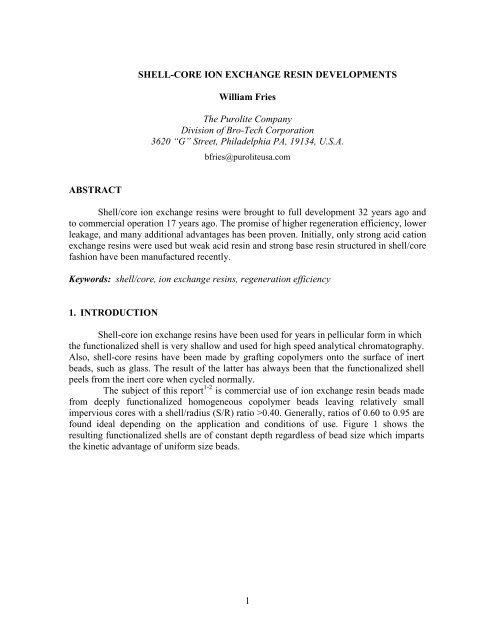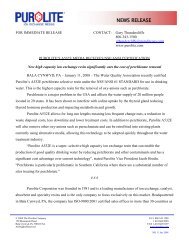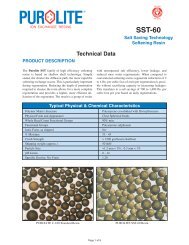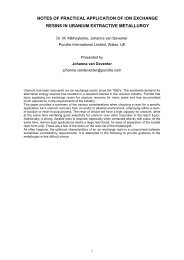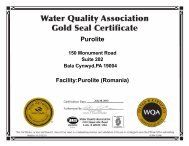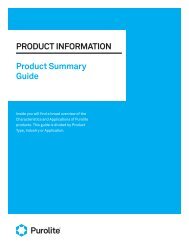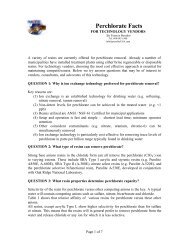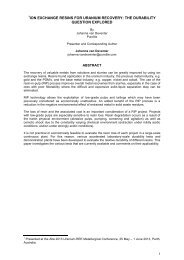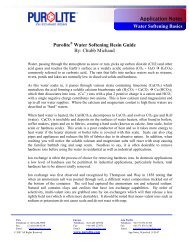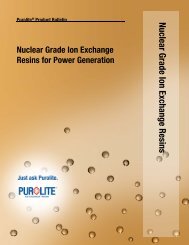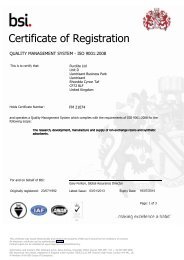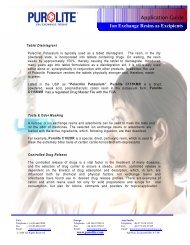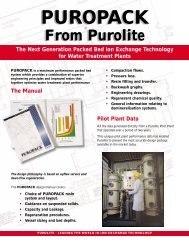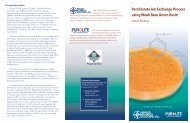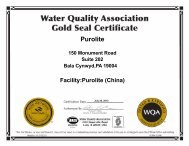Shell core ion exchange resins - Purolite
Shell core ion exchange resins - Purolite
Shell core ion exchange resins - Purolite
- No tags were found...
Create successful ePaper yourself
Turn your PDF publications into a flip-book with our unique Google optimized e-Paper software.
Table 7: Samoan two-bed de<strong>ion</strong>izat<strong>ion</strong> study31% greater through-put from shell-<strong>core</strong> SAC41% yearly savings in acid and waterLonger runs on the following standard SBA resin saving $35,000on NaOHSodium leakage slightly lower.4. Another commercial case study replaced a standard SAC resin in a parallel twobedde<strong>ion</strong>izat<strong>ion</strong> train at Elekeiroz, a Brazilian chemical intermediates producer.Table 8: Brazilian chemical company73% saving of H 2 SO 4 (shell-<strong>core</strong> SAC)29% saving of NaOH (Std. SBA)5. Two-bed lactic acid de<strong>ion</strong>izat<strong>ion</strong> was studied in which the shell-<strong>core</strong> SAC resinbed (counter-flow acid regenerat<strong>ion</strong>) gave 45% longer throughput at lower regenerat<strong>ion</strong>levels and half the rinse water consumpt<strong>ion</strong> in commercial use.In fact, the shell-<strong>core</strong> SAC resin throughput capacity was affected little by the HClregenerat<strong>ion</strong> level used.Table 9: Lactic acid two-bed de<strong>ion</strong>izat<strong>ion</strong> study (capacity used, meq mL -1 )Regenerat<strong>ion</strong> Level, lbft -3 Std. Macro Resin Std. Gel Resin <strong>Shell</strong>-CoreResin8.8 (141 g/l)7.4 (118.5 g/l)5.6 (90 g/l)4.4 (70 g/l)0.640.610.580.520.760.690.660.470.780.800.760.762.3 Mixed-Bed De<strong>ion</strong>izat<strong>ion</strong>A mixed-bed study with a shell-<strong>core</strong> SAC resin component produced high qualitywater more abundantly in a Philadelphia lab study. No advantage in lower quality waterproduct<strong>ion</strong> was seen.9
0.067Water Quality(cond., μS cm -1 )Table 10: High quality water product<strong>ion</strong>Std. Mixed-BedCapacity,(meq mL -1 )5010.20.10.150.660.580.540.38Mixed-Bed with S/CSAC Capacity,(meq mL -1 )0.330.590.450.440.402.4 Sugar ChromatographyA lab study was made of the commercial process of separating glucose and fructoseto produce High Fructose Corn Syrup using SAC resin in the calcium form. Acceptedindustry test methods were used. The first test was hot water rinse-out rate of <strong>resins</strong>aturated with 50% dextrose. The second was actual column chromatographic separat<strong>ion</strong>efficiency of glucose and fructose in a mixed stream.In the former (Table 11) the time required to reach a specific low glucose level isless as the S/R ratio of the resin decreased indicating faster diffus<strong>ion</strong> kinetics.In the latter (Table 12) the separat<strong>ion</strong> efficiency of the shell/<strong>core</strong> resin isuninfluenced by the uniformity of the resin’s bead size (higher UC = less uniform bead sizedistribut<strong>ion</strong>) and whether the beads are stratified by size or remain randomly mixed. Beadstratificat<strong>ion</strong> is known to harm chromatographic performance but not in the case of shell<strong>core</strong><strong>resins</strong>.Table 11: Glucose rinse-out rate (minutes to glucose level)<strong>Shell</strong>/Radius Ratio 10% 5% 3% 1%1.0 std.0.720.391258576136968414610595174150145<strong>Shell</strong>/RadiusRatio1.0 std.1.00.750.75Table 12: Glucose-Fructose separat<strong>ion</strong>Mean Size Uniformity Separat<strong>ion</strong> Indexmicrons Coefficient mixed bed4571.1544571.5604331.1604331.560Separat<strong>ion</strong> Indexstratified bed5552606010
2.5 Weak Acid Resin (WAC) ExampleWAC resin in shell-<strong>core</strong> form was used in simulated hot brine softening withstandard co-flow regenerat<strong>ion</strong>.The regenerat<strong>ion</strong> level was able to be reduced substantially while maintaining ahigher operating capacity than standard WAC resin.Table 13: Hot brine softening (recycling) in lab simulated oil recovery(co-flow HCl regenerat<strong>ion</strong>)Regen. Level Capacity (kg ft -3 ) to 0.2 ppm hardness Heel, ppm, hardnesslb HCl ft -3 Std. Resin <strong>Shell</strong>-Core Resin Std. <strong>Shell</strong>-Core9 (144 g L -1 )6.8 (109 g L -1 )24 350 310.7 02.1 1.42.6 Strong-Base An<strong>ion</strong> Resin (SBA) ExampleAn aggressive synthetic water made by extracting humic soil containing high levelsof SiO 2 , colloidal SiO 2 , and fulvic acid foulant. This was de<strong>ion</strong>ized with parallel two-bedlab systems. One system contained shell-<strong>core</strong> SBA resin (patent pending) in the lagposit<strong>ion</strong>; the other a standard SBA resin.The shell-<strong>core</strong> SBA resin train produced consistently lower silica and fulvic acid leakagethan the parallel system of all standard <strong>resins</strong>. The fulvic acid foulant was regenerated moreeffectively with caustic regenerat<strong>ion</strong> using3 lb NaOH ft -3 (48 g L -1 ) regenerat<strong>ion</strong> levels.Table 14: Aggressive water de<strong>ion</strong>izat<strong>ion</strong>ResinStd. SBA<strong>Shell</strong>-Core SBACapacity,(meqmL -1 )0.300.28Fulvic Acid Leakage(%)112SiO 2 Leakage(%)43Average Cycles: 2 – 5; Water Composit<strong>ion</strong>: SiO 2 =20.5 ppm, Colloidal SiO 2 = 2.3 ppmTOC as Fulvic Acid = 14.3 ppm2.7 Other CharacteristicsThere are a number of accepted accelerated lab tests that predict the stability of <strong>ion</strong><strong>exchange</strong> resin beads. All were used to test the long term stability of shell-<strong>core</strong> (SAC)resin with an appropriate standard resin control. The results show consistently moreresistance by the shell-<strong>core</strong> <strong>resins</strong>, particularly as the S/R ratio decreases.No instance of significant instability of shell-<strong>core</strong> <strong>resins</strong> beads has been reported inseventeen years of commercial use.1. <strong>Shell</strong>-<strong>core</strong> resin decreases in reversible swelling 1 (acid to base cycling) asshell/radius ratio decreases.11
Table 15: Reversible swelling<strong>Shell</strong>/Radius Ratio %Swelling1.0 std.70.6460.4612. <strong>Shell</strong>-<strong>core</strong> resin resists accelerated oxidat<strong>ion</strong> 1 using 6% H 2 O 2 and 1000 ppm Fe +3 ,as a catalyst. The loss in resin solids and dry weight are equated with <strong>ion</strong> <strong>exchange</strong> resindecrosslinking that occurs naturally in commercial use (Table 16).Table 16: Accelerated oxidat<strong>ion</strong><strong>Shell</strong>/RadiusRatio% Resin SolidsLost% Resin DryWeight Loss1.0 std.0.725.92.9713. Acid-base cycling stability 1 increases with lower S/R ratio Table 17.Table 17: Accelerated acid/base stability<strong>Shell</strong>/Radius Ratio % Loss of Perfect Beads1.0 std.0 to 50.730 to 10.4004. Crush resistance 1 increases with lower S/R ratio (Table 18).Table 18: Crush resistance<strong>Shell</strong>/Radius Ratio Average Breakpoint,g/bead0.972930.792900.733220.603785. The size uniformity of copolymer beads increases (lower UC) with initial shellsulfonat<strong>ion</strong> to a point where the S/R ratio is about 0.5, after which the uniformity decreasesagain when proceeding onward towards full funct<strong>ion</strong>alizat<strong>ion</strong> (S/R ratio = 1).12
Table 19: Bead size uniformity<strong>Shell</strong>/Radius Ratio Uniformity Coefficient0.00 copolymer1.370.481.160.501.150.641.281.00 std. resin1.533. RESULTSThe theses proposed in the Introduct<strong>ion</strong> are substantiated individually with specificexamples, all commercially related. Generally, <strong>ion</strong> <strong>exchange</strong> resin made with deeplyfunct<strong>ion</strong>alized shells and impervious <strong>core</strong>s is shown to operate more efficiently, particularlyin regenerat<strong>ion</strong> efficiency and subsequent effluent quality. This concept is broadened toinclude SAC, WAC, and SBA <strong>ion</strong> <strong>exchange</strong> <strong>resins</strong> and suggests it can be broadened furtherto all absorbents. Further, the resin beads have superior stability in normal <strong>ion</strong> <strong>exchange</strong>resin cycling.AcknowledgementI must recognize all the organizat<strong>ion</strong>s that are using these SST <strong>resins</strong> and tookthe effort to document the results herein.REFERENCES1. Fries William, Superior performance of <strong>ion</strong>-<strong>exchange</strong> <strong>resins</strong> with short, optimaldiffus<strong>ion</strong> paths – SDP <strong>resins</strong>, Reactive Polymers, 19, 97-104 (1993).2. Fries William, Ion <strong>exchange</strong> <strong>resins</strong>, European Patent EP0361685, 01/19/19943. Downey Don, SST-60 Shallow <strong>Shell</strong> Strong Acid Cat<strong>ion</strong> Resins, <strong>Purolite</strong>.com.4. Heller Terence, Iron Removal with SST Ion Exchange Resins, <strong>Purolite</strong>.com.5. Boodoo Francis, Enhancing RO Permeate Recoveries with Cyclic Ion Exchange, IWCSan Antonio, TX, IWC 10-56.6. Downey Don, Use of Seawater to Regenerate PUROLITE R SST-80 Shallow <strong>Shell</strong>SAC Resin, IWC 11-06.7. Downey Don, Producing High-Purity Water with Shallow-<strong>Shell</strong> Resins, UltrapureWater, 18(6), 20, 22-24,26 (July/August 2001).8. Anon, Demineralizat<strong>ion</strong> Cost Reduct<strong>ion</strong> News, Reported independently byDemineralizat<strong>ion</strong> Cost Reduct<strong>ion</strong> News, Div. Indumark, New York, NY, February2009.9. Case History, SST-60 Shallow <strong>Shell</strong> Strong Acid Cat<strong>ion</strong> Resin.13


